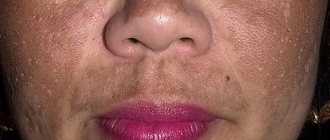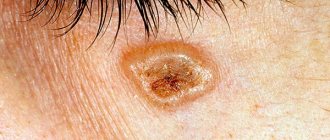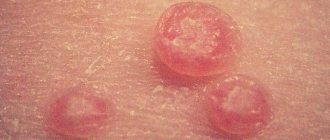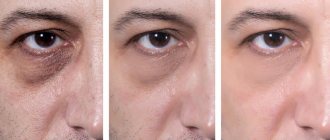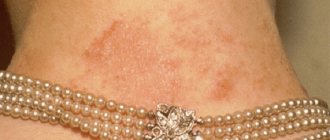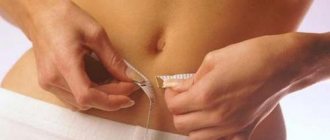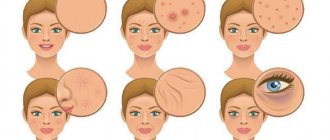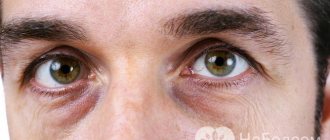Swelling of the eyes due to a runny nose
They say that if a runny nose is treated, it goes away in 7 days, and if left untreated, it goes away in a week.
So is it worth spending time and money? Definitely worth it to avoid complications - sinusitis, or, as it is called in everyday life, sinusitis. This disease is characterized by severe difficulty in nasal breathing; the nose is usually blocked on both sides, but alternating blockage of the right and left nostrils also occurs. In most cases, the patient experiences mucous (transparent) or purulent discharge from the nose. However, if the nose is very stuffy, there may not be a runny nose, since the outflow of mucus from the sinuses is difficult.
Unpleasant sensations in the nose and paranasal area, and sometimes pain due to sinusitis, gradually increase: in the evening they are more pronounced than in the morning. In acute sinusitis, body temperature can rise to 38 C or higher. In a chronic process, it rarely increases. General malaise is manifested by fatigue, weakness, sleep disturbances, including difficulty breathing.
Manifestations of the disease depend on which sinus is affected. With inflammation of the frontal sinus - frontal sinusitis - dull pain in the forehead is bothersome, often in the morning when a person wakes up. With inflammation of the maxillary sinus (sinusitis), pain occurs in the area of the upper jaw and teeth, and pain is felt when touching the cheek on the affected side. Due to the close location of the sinuses to the tear duct in the corner of the eye, inflammation may be accompanied by swelling of the eyelid and pain in the area between the eyes. In addition, the sense of smell is sometimes impaired and pain occurs when touching the nose and swollen area. Inflammation of the sphenoid sinus (sphenoiditis) is rare.
Then the localization disappears and the whole head begins to ache if both halves of the nose are blocked, but if the inflammatory process is one-sided, then the headaches are one-sided, pain in the ears and neck is noted.
Sinusitis (sinusitis, frontal sinusitis, ethmoiditis, sphenonditis) is an infectious inflammation of the paranasal sinuses, in which swelling of the mucous membrane occurs and blocks the anastomosis between the nasal cavity and the maxillary sinus. A person has several of them: these are the maxillary sinuses (maxillary sinuses), which are located in the thickness of the upper jaw; lattice, located behind the bridge of the nose; sphenoidal, located at the base of the skull, and the frontal sinus. Each of them opens into the nasal passages. Through the openings (ostia) of these sinuses, air is exchanged and mucus is released. The mucous membrane of the paranasal sinuses passes into the nasal cavity. Therefore, any inflammatory process in the nasal cavity, which causes swelling of the mucous membrane, causes an inflammatory process in the sinuses. This happens in the following sequence: swelling of the mucous membrane - closure of the anastomosis - accumulation of mucus in the sinus cavity. It puts pressure on the walls of the sinus, which causes pain. In the sinus, the production of mucus continues, which, due to a violation of the outflow, stagnates and the process gradually becomes inflammatory in nature. This exudate is a breeding ground for the introduction of new and development of existing bacteria and viruses in the body. In the process of life, they produce toxins that are carried through the bloodstream throughout the body and become the cause of general malaise.
Gradually, the mucus turns into pus of a viscous consistency, so it is poorly evacuated from the sinus; even when the anastomosis is open, it can fill the entire sinus. If treatment is not started promptly, purulent contents may break into the surrounding structures. For example, in the eyes: gradually increasing swelling of the eyelids appears, they turn red, and even protrusion of the eyeball forward (exophthalmos) may appear.
There are many reasons for the occurrence of sinusitis. But the main one is an infection: bacteria or viruses penetrate the maxillary sinus through the nasal cavity (mouth, pharynx) or through the blood and cause an inflammatory process. Conditions that impair nasal breathing predispose to the development of sinusitis: congenital disorders of the development of the anatomical structures of the nasal cavity, deviated nasal septum, vasomotor rhinitis, hypertrophic rhinitis (enlargement of the nasal turbinates), and in children - adenoids. hay fever.
Immunity disorders and untimely or incorrect treatment of ARVI. rhinitis creates an almost 100 percent guarantee of the development of this disease.
A bacterium called “staphylococcus” can live in the nasopharynx for a long time and not manifest itself in any way, but under unfavorable conditions, for example, during a cold, it causes inflammation in the sinuses.
But most often sinusitis is provoked by acute respiratory viral infections and influenza. parainfluenza, infections penetrating from diseased teeth (odontogenic sinusitis), allergies (allergic sinusitis) ... Almost all viruses that affect the upper respiratory tract (causative agents of ARVI) can cause sinusitis, since the epithelium of the paranasal sinuses is very similar to the epithelium of the respiratory tract and viruses also affect this part of the respiratory tract. Fortunately, viral infections such as influenza, parainfluenza, and adenovirus provoke only acute forms of sinusitis; they are not capable of causing chronic sinusitis. Despite the fact that the main role in the development of chronic sinusitis is played by bacteria (streptococci, staphylococci), as well as protozoa - chlamydia and mycoplasma (often causing sinusitis in children), it is important to properly treat viral diseases, otherwise a viral infection may be replaced by a bacterial one.
Diseases of the ENT organs are no less common cause of sinusitis than infections. Acute and chronic rhinitis can lead to the development of sinusitis due to blockage of the maxillary sinus outlet (connects the cavity of the maxillary sinus with the nasal cavity) through which the sinus is drained and cleansed. Chronic tonsillitis can serve as a source of infection, which is introduced into the maxillary sinus when blowing the nose. Chronic pharyngitis, as well as chronic tonsillitis, can play the role of a source of infection in the development of sinusitis. A deviated nasal septum can cause sinusitis due to pathological narrowing of the new passage and impaired drainage and ventilation of the maxillary sinus.
The doctor can assume that the patient is suffering from sinusitis based on the symptoms. However, it is not always possible to accurately localize the affected sinus. To clarify the diagnosis and identify the main focus of the inflammatory process, radiography or a more informative diagnostic method is prescribed - computed tomography (CT) of the paranasal sinuses.
Even theoretically, sinusitis, unlike acute rhinitis, will not go away on its own, and self-medication can end very badly. Therefore, at the first suspicion of sinusitis, you should immediately contact an otolaryngologist.
The basis of treatment is the fight against swelling of the nasal mucosa. This means that you need to ensure a good outflow of discharge from the sinuses.
Drugs for local therapy are prescribed - drops (vasoconstrictors), sprays, inhalers that can eliminate swelling of the mucous membrane. They should be used like this: lie on your side, drip vasoconstrictor drops into the nostril that is closer to the pillow so that the medicine gets on the side wall of the nose, and lie there without moving for 5 minutes. Then you need to turn over to the other side and do the same with the other nostril. After another 5 minutes, blow your nose. Then you need to instill antibacterial, anti-inflammatory or analgesic drops prescribed by your doctor. Antibacterial drugs and antihistamines are used in treatment. A method of rinsing the nose with antiseptic (furacillin) solutions is often prescribed. Many people are familiar with the method of moving fluid known as “cuckoo”. The patient lies on the couch on his back. The doctor asks the patient to say: “Ku-ku-ku-ku” so that the communication between the nasopharynx and the oropharynx overlaps. At this time, a medicinal solution is slowly infused into one nostril, with simultaneous suction from the other nostril using a vacuum device. Negative pressure promotes the evacuation of pus from the sinuses, and the medicinal solution, intensively moving through the nasal cavity, flushes the sinuses. Additionally, physiotherapy is prescribed. UFO, UHF.
Many people, just hearing the diagnosis of “sinusitis” or “sinusitis,” panic and are afraid to pierce the maxillary sinus. It is believed that once you do this, you will have to inject it endlessly. But without indications, doctors do not prescribe sinus puncture. In some situations you simply cannot do without it. For example, if the anastomosis cannot be opened by other methods and pus does not come out of the sinus, there is a risk of it breaking into the surrounding tissue. During the puncture, pus is pumped out, the sinus cavity is washed, and then antibiotics and anti-inflammatory drugs are injected into it. Of course, the procedure is not the most pleasant, but it is very effective. And if a relapse (repeated inflammation of the sinuses) occurs, it is either due to the fact that the treatment of sinusitis was not completed, or other factors predispose to its development. For example, sinusitis occurring against the background of a deviated nasal septum is characterized by a long course and treatment, as well as frequent relapses. But this problem can be solved with the help of surgery to restore the nasal septum.
Puffiness under the eye during a cold
Usually in the morning, after waking up, you can notice swelling under the eyes. Of course, the first thing that comes to mind is not a rash. Such a reason is also possible, but sometimes swelling under the eye can be the cause of some internal disease. the reason is a violation of venous and lymphatic outflow.
Edema can occur in both adults and children. The etiology, symptoms and treatment will be the same in both cases. It can also be under the left, right eye, or under both. There is no need to immediately look for ointments to relieve swelling; it would be better to consult a doctor.
The mechanism of edema
The skin around the eye consists of epidermis and fatty tissue, between which there is a membrane. the function of the membrane is to prevent the subcutaneous tissue from leaving its location.
The increase in the amount of intercellular fluid increases as follows: the liquid part of the blood (water, salts and in some cases protein) sweats out of the vascular bed. This can be caused by vascular pathology, hypertension, trauma and other reasons.
What reasons can cause swelling under the eyes?
It is foolish to assume that lack of sleep alone causes swelling on the face. In fact, there are many reasons:
- renal pathology;
- diabetes;
- water-electrolyte imbalance;
- injuries to the facial part of the skull;
- ARVI, Influenza;
- inflammatory diseases of the paranasal sinuses;
- allergic reaction (Quincke's edema);
- overwork, lack of sleep, spending long periods of time at the computer, etc.
The first and main reason suggested by the presence of swelling under the eyes is renal pathology.
Swelling under the eye is one of the first symptoms that are a sign of impaired kidney function. These can be various kidney diseases, such as pyelonephritis, glomerulonephritis, urolithiasis or renal failure.
In this case, swelling under the eye is formed as a result of a violation of the filtration function of the kidneys. The rate of urine production decreases significantly and excess fluid occurs in the body, which ultimately leads to moderate to severe hypertension. An increase in pressure in the vessels leads to overstretching of the vessel walls and, as a result, the formation of edema.
Since when lying down, blood is redistributed and blood pressure increases in the upper parts of the body, swelling under the eyes is especially noticeable in the morning.
If a patient has hypertension, swelling under the eye will not occur, because, despite the increased pressure, there is no excess fluid.
In the morning, edema can also be observed in people with diabetes mellitus, as they drink large amounts of fluid. In general, almost all people who drink a lot of water will have puffy eyes in the morning.
The reason for their development can also be a violation of the water-electrolyte balance with an increase in the amount of salts in the tissue fluid. This condition causes salts to retain water and prevent it from leaving the body.
Injuries to the facial part of the skull may also be accompanied by swelling. That, however, the distinguishing feature will be either pronounced hyperemia or hematoma. Injuries can be of a wide variety of nature, be it a bruise, broken bones, abrasion, or rupture of soft tissues and skin. In this case, there will be swelling above the eye, under it, right up to the temple.
Swelling under the eyes can appear during a cold (Flu, ARVI). In this case, the inevitable symptoms will be rhinorrhea (runny nose), fever, cough, sore throat, conjunctivitis. With a cold, the diagnosis will be clear from the first minutes.
Sinusitis, frontal sinusitis, sinusitis are inflammatory diseases of the paranasal sinuses, in which swelling can be located under the left, right and both eyes.
In this case, the patient will experience severe pain in the paranasal sinuses, head, rhinorrhea and increased body temperature.
You need to seek help from an ENT doctor; to make a diagnosis, you need to do a general blood test and an x-ray of the facial skull.
With Quincke's edema, not only the eyes swell, but also the face and neck. It becomes difficult for a person to breathe and a dry cough appears. Quincke's edema is an allergic reaction, and when it appears, you must urgently call an ambulance, otherwise everything can end in death. Allergies can manifest themselves simply as increased tearing and swelling under the eyes.
Eyes may swell from extreme fatigue. When the body often gets tired and does not have time to rest, bruises and swelling under the eye can occur as a result of overexertion.
Chronic lack of sleep can cause swelling under the eyes. If you don’t get enough sleep for a day or two, then there is no problem, swelling should not appear.
But if this is a systematic condition, maybe we should give it due attention and solve the problem.
After all, swelling under the eye is not the only consequence; due to the fact that the body does not rest properly, more serious diseases can arise.
Clinic
The main clinical manifestation will be an increase in the volume of the upper and lower eyelids. The remaining symptoms will depend solely on the cause that caused this swelling under the eye. In cases with impaired water-electrolyte balance and renal function, additional symptoms will appear exclusively related to the affected organ.
If the swelling is caused by an injury, then an important symptom will be pain when palpating the swelling. Most often, swelling associated with injuries leads to hemorrhages not only in the eyelid, but also in the sclera of the eye.
Swelling caused by injuries is most often the most visible and massive, because...
a much larger amount of blood enters through damaged vessel walls than when plasma leaks through an overstretched wall.
Treatment
Specific treatment is required for any cause of swelling under the left and right eyes, without exception, since swelling is only a symptom and not a separate disease. For almost everyone, the use of ointments and physiotherapy aimed at improving microcirculation and having a resolving effect is suitable. All these methods will help relieve swelling.
For allergic reactions, it is necessary to use desensitizing drugs or corticosteroids, depending on the severity of the allergic reaction (for banal pain in the eyes and swelling, you can use regular diazolin, for Quincke's edema, hormones).
Injuries require the prescription of painkillers that will help relieve pain, reduce spasm and reduce blood flow to the injured area, which will help the swelling subside and prevent its further development.
Each kidney disease requires a variety of treatments. Glomerulonephritis - the prescription of antirheumatoid drugs, pyelonephritis - antibiotics, and renal failure - general emergency treatment.
If you have a cold, swelling under the eye does not require treatment. Once the disease is treated, it will go away on its own.
If swelling occurs against the background of overstrain of the body, fatigue, or lack of sleep, then you should first reconsider your rest regimen. You need to devote more time to sleep, try to walk in the fresh air more often, do exercises, you can, with the permission of your doctor, take general strengthening agents and vitamins.
You should try to avoid stressful situations. If in this case the swelling cannot be removed, then the cause may be deeper and you need to consult a doctor.
You should not be dismissive of the fact that there is swelling under the eyes on your face when you see them in the mirror on your face in the morning. This may be a harbinger or the first sign of the development of a serious illness in the body. And the very first thing you should do is consult a doctor. Early diagnosis and treatment are the key to health.
Source: https://pro-oteki.ru/lico/pod-glazom-vo-vremya-prostudy
Why does swelling develop?
Human nature is designed in such a way that edema is a natural protective reaction of the body to the development of inflammatory processes, in particular sinusitis.
It is necessary to distinguish affected tissues from healthy ones, as well as to prevent the development of infection. But, despite the fact that it is a defensive reaction, excessive swelling of the nose during sinusitis can cause a whole range of unpleasant sensations.
The cause of edema is the interaction of immune cells with bacteria or viruses that have entered the cavity of the paranasal sinuses and the release of pro-inflammatory mediators by leukocytes - cytokines and interleukins.
This group of substances is a chemical, informational signal for other immune cells about the presence of a source of infection in the body, and ensures the active migration of new leukocytes to the area of the maxillary sinus.
The effect of these substances on the capillaries causes their expansion, increased permeability of the vascular wall and, as a result, the release of fluid from the bloodstream into the surrounding tissues, which, in fact, is edema.
How to remove a bag under a baby's right eye
Sometimes children, as well as adults, may experience discomfort in the form of a swelling under the eye. The causes of childhood swelling are not much different from adult swelling. But in children this defect is often congenital. This is explained by the peculiar structure of the tissues around the eye - the fatty membranes.
Unexpected swelling, accompanied by painful sensations in the body, should be a signal to the adults around the child.
In this case, the pediatrician will diagnose the cause of the swelling and determine how to remove the bag under the right eye.
Where does swelling develop?
With a prolonged course of the inflammatory process, swelling from the maxillary sinus can progress to:
- On the face area;
- Gums;
- Orbital fiber.
This is due to the fact that the walls of the paranasal sinuses are very thin and reach only a few millimeters in thickness.
When the mucous membrane of the nasal cavity and anastomosis swell, their connection with the external environment and the air circulating during breathing is disrupted, because of this, the sinuses cease to play the role of resonators and the voice changes and becomes nasal, and in addition to this, a large amount of nasal discharge is also observed.
Watery eyes and swelling under the eyes.
As swelling spreads upward, the tear ducts narrow and the tissue around the eyeball swells. All this leads to lacrimation, since tears from the eye cannot flow into the nasal passages, as is usually the case and “pouring out”, and swelling of the fiber causes the development of bags under the eyes and discomfort, even pain.
Disruption of the normal movement of tear fluid in combination with a nearby inflammatory process leads to the development of secondary, often non-bacterial, conjunctivitis, sometimes accompanied by such significant swelling that it is almost impossible to open the affected eye.
Swelling of the tissues around the sinuses.
If the swelling spreads forward, then the skin of the face swells to a greater extent in the projection of the sinus. It becomes pale, and upon palpation, pain can be detected.
Physiological causes of edema
As a rule, the right eye swells due to eating excessive amounts of fatty, salty, fried or spicy foods. Stagnation of fluid in the tissues of the body often occurs during a late dinner immediately before bedtime - a person’s right eye swells in the morning.
There are other factors that cause severe swelling of the face and eyes. These include:
- drinking alcoholic beverages, smoking;
- an adverse reaction to taking certain medications (including those prescribed by a doctor);
- severe fatigue of the body, regular lack of sleep, violation of the daily routine;
- drinking a large volume of water before going to bed;
- genetic predisposition.
How to get rid of swelling?
To relieve swelling, it is necessary to influence the mechanism of its development. Most often, vasoconstrictor drugs are used for this, for example, naphthyzin, sanorin or Nazivin .
These drugs act on the muscle cells located in the walls of the capillaries, after which the capillaries narrow, their permeability decreases, and, consequently, the amount of fluid in the surrounding tissues.
Antihistamines.
Another, no less important in the complex treatment of sinusitis, group of drugs are antihistamines. They affect the activity of immune cells, preventing them from producing histamine, a substance that increases swelling.
This group of drugs includes erespal, claritin or loratadine . Including them in the treatment regimen will help reveal the effects of other drugs more fully.
Folk remedies to combat edema
Peppermint candies can relieve swelling both during sinusitis and simple viral infections - due to their local irritating effect, they activate the vascular reflex, as a result of which, even without the use of any medications, a short-term but very noticeable decrease in swelling of the mucous membrane can occur nose
However, you should not completely rely on them , because after the candy is absorbed, the swelling will return in a few minutes.
In addition, inhalations from:
- Sage;
- Chamomiles;
- Cedar oils;
- Fir and calendula;
- Vegetable and essential oils for sinusitis have a special softening effect and accelerate the circulation of accumulated blood.
All these plants contain antibacterial substances, which, when inhaled with steam, enter the nasal cavity and help cope with the infection. They are also tonics, which means they activate the body’s reserves, which are so necessary during illness.
It is worth remembering that here are recommendations aimed only at a short-term and fastest possible effect, so that you can cope with swelling in any life situation. After which it is imperative to seek help from a medical institution, because once you have dealt with sinusitis forever, you will also get rid of its symptoms.
Source: gaimoritus.ru
Prevention of edema
To prevent eye swelling, you need to know what to do:
- Strictly follow the correct daily routine, sleep at least 8 hours a day.
- Avoid consumption of alcohol, tobacco, and salty foods.
- Try not to overload your eyes with computer work and reading, give your eyes periodic rest, and do eye exercises.
- At the first symptoms of swelling, make overnight lotions with chamomile infusion or tea bags.
- Wipe your eyelids every morning with ice cubes made from mineral water or herbal decoctions.
Always before you start fighting edema, you need to understand their causes. If the eye is swollen and there is a suspicion of inflammation or infection, you should immediately consult a doctor.
Causes
Why does tearing, sneezing and runny nose occur? The mentioned symptoms most often indicate an infectious or allergic lesion of the mucous membranes of the nose and paranasal sinuses. Sneezing and rhinitis are protective reactions of the body, thanks to which pathogenic viruses, microbes and allergens are removed from the respiratory tract. Tearfulness is a consequence of inflammation of the nasolacrimal ducts, leading to disruption of the outflow of fluid from the lacrimal sac.
The absence of temperature during rhinitis and lacrimation in approximately half of the cases indicates the development of an allergic reaction.
Constant sneezing is an alarming symptom that precedes the development of colds. During forced and sharp exhalation, the respiratory tract is cleared of irritating substances - dust, animal hair, gas molecules, viruses, etc. If the first manifestations of the disease are not stopped in time, this will subsequently lead to the development of a runny nose. Inflammation of the mucous membranes stimulates the secretion of nasal mucus, which causes nasal congestion.
Principles of treatment
How to treat if your eyes water when you have a runny nose? As already mentioned, lacrimation in most cases occurs due to inflammation of the nasolacrimal duct. With adequate treatment of inflammation in the nasopharynx, the outflow of tear fluid is normalized, thereby eliminating unwanted manifestations of the disease.
As a rule, treatment begins with taking medications that eliminate the direct cause of rhinitis - infection. For a cold, pathogenic flora in the nasopharynx can be destroyed using antiviral agents: Anaferon, Groprinosin, Ingavirin, Lavomax, Arbidol, etc.
In addition, it is recommended to use symptomatic medications, which can stop coughing, sneezing, lacrimation and rhinitis.
You can speed up the process of clearing the respiratory tract from infection with the help of sanitizing procedures and inhalations. Irrigation of the nasopharynx with anti-edematous and wound-healing medications can quickly ease nasal breathing and reduce the severity of inflammation in the mucous membrane. In case of allergic damage to the ENT organs, it is possible to relieve the symptoms of the disease with the help of systemic and local antihistamines.
Antiallergic drugs
What should you do if your eyes water when you have a runny nose? The combination of symptoms often indicates the development of allergic rhinitis. If an irritating substance (allergen) penetrates the respiratory system, this leads to inflammation of the mucous membranes. It is worth noting that the patient’s general well-being is practically not affected - there is no temperature, body aches or sore throat.
Allergic rhinitis is not a harmless disease, since severe swelling of the nasal mucosa can lead to inflammation of the auditory tube and, as a consequence, the development of otitis media. If your eyes begin to water, and your nose begins to itch or burn, you should seek help from an immunologist or allergist. The following antihistamines can be used to relieve allergic manifestations:
Modern antiallergic drugs affect the mechanisms of development of edema in the mucous membrane of the nasopharynx and nasolacrimal duct. Therefore, with timely use of medications, after a couple of days, patients’ rhinitis disappears and lacrimation stops.
Means for prevention
Remember, the formation of edema may be associated with individual physiological characteristics. This includes nutrition, bad habits, and lifestyle in general.
To eliminate swelling, you can do the following as a preventive measure: ventilate the room before going to bed (oxygen deficiency leads to swelling), sunbathe in moderation (excess ultraviolet radiation negatively affects the skin), and do gymnastic exercises.
If possible, do not drink (especially in the evenings) alcoholic and coffee drinks, salty and spicy foods. Try to drink as much fluid as possible throughout the day. Drink up to two liters of clean water, most of it before 2 pm. If there is a lack of fluid in the body, it uses its reserves and “stores water,” resulting in bags on the eyelids.
Remember that morning bags under the eyes, especially on one side, appear due to improper sleeping position. Try to sleep on your back rather than on your side or stomach. Do not use a pillow that is too low, this will prevent excess fluid from accumulating in the eyelid area.
If you suffer from allergic reactions, during the season of exacerbations, try not to come into contact with allergens or take medications for prevention.
Don't forget about cosmetics that protect against ultraviolet radiation. Excessive sunbathing causes swelling of the skin.
Inhalation with a nebulizer
Aerosol inhalation is one of the most effective physiotherapeutic procedures, thanks to which it is possible to quickly eliminate almost all local manifestations of a cold - nasal congestion, sneezing, coughing, sore throat, etc. Unlike oral tablets, the aerosol penetrates directly into the lesions. Due to this, the concentration of antimicrobial, antiviral and anti-inflammatory substances quickly increases in inflamed tissues.
In order for the nose to stop stuffy, you need to eliminate inflammation and swelling in the mucous membrane. For these purposes, drugs with anti-edematous, immunostimulating, antibacterial and antiviral effects can be used:
To increase the effectiveness of nebulizer therapy, before inhalation it is recommended to drip vasoconstrictor drops into the nose - “Rinza”, “Galazolin”, “Naphthyzin”, etc.
Sanitation of the nasopharynx
How to treat a stuffy nose and watery eyes? Nasal drops help eliminate inflammation in the nasal cavity, but they have virtually no effect on the condition of the mucous membrane in the paranasal sinuses. To ensure that mucus and infectious agents contained in it are washed out of the nasopharynx and paranasal sinuses, it is recommended to carry out sanitizing procedures.
Rinsing the nose with saline solutions helps normalize the outflow of intercellular fluid from the lesions. In addition, preparations based on sea salt have a beneficial effect on the condition of the mucous membrane, accelerate its regeneration and increase local immunity. Sanitation procedures are recommended for the development of a runny nose of any etiology. Anti-inflammatory and antiseptic agents destroy pathogenic agents in the ENT organs and thereby accelerate recovery.
Important! You should not tilt your head back while rinsing your nose, as the liquid can penetrate the auditory tube and cause inflammation in it.
To rinse the nasopharynx the following can be used:
- “Physiomer” is a solution based on sea salt, has an anti-edematous and wound-healing effect;
- “Quix” is a mucolytic agent that helps to liquefy and remove mucus from the paranasal sinuses and nasal passages;
- "Dolphin" is an isotonic solution based on sea salt, which accelerates the healing process of the nasopharyngeal mucosa.
Sanitation of the nose should be carried out at least 3-4 times a day during exacerbation of respiratory diseases. Regular rinsing of the nasopharynx and irrigation of the mucous membrane can eliminate a severe runny nose within a few days.
Source: globalmedclub.ru
Bag under the left eye and its treatment
When, after undergoing an examination and determining the causes of swelling, the most effective treatment method is selected.
If, as a result of an examination by specialists, it turns out that swelling under the eye acts as a symptom of the disease, then efforts should be directed toward treating the disease itself.
If it is determined that the bag under the left eye is a consequence of a cosmetic defect, then you need to slightly adjust your behavioral habits, namely:
- Change the nature of lighting in the workplace, at home in the kitchen or office, garage.
- Try to provide maximum natural light in the premises.
- When working in front of a computer monitor, you should take breaks more often.
- When using cosmetics, which often causes a bag to appear right under the left eye, you should get rid of makeup at night with special cosmetic preparations and a light skin cream.
- In the evening, you do not need to eat salty foods, plenty of fluids, and drinking alcoholic beverages is undesirable. By adhering to this rule, you can also protect yourself from bags under your left eye.
- A full, long night's sleep and a well-chosen pillow that does not provoke spasms of the neck muscles have a good effect on the condition of the skin around the eyes.
Stuffy nose, swelling
For the third day now, my nose is terribly stuffy. On the very first day of congestion, I went to the Laura, nothing serious, prescribed Maurice (an analogue of Nasonex) morning and evening, Sinupret, rinsing, everything as usual. I wash the house with a blue “teapot” from aquamaris. The congestion does not go away at all. ENT said to drip vasoconstrictors from time to time so that the nose can breathe and the snot comes out, but in fact I drip and after an hour and a half it’s stuffy again. You start Googling, everyone writes “you need rinses for a stuffy nose” - but how to do them. how can you rinse your nose when it is blocked and water does not flow through it?? what nonsense? I also can’t always take drops, because I stupidly feel that I’m already seriously swollen, everything hurts, and I don’t want to get used to the drops. What to do? Maurice has already dripped 5 times - it hasn’t gotten better yet, except that she started sleeping normally at night. Does anyone have experience dealing with nasal swelling?
I always apply hot salt on the first day. try it's not too late.
The administration of the Woman.ru website does not evaluate recommendations and reviews about the treatment, drugs and specialists discussed in this thread. Remember that the discussion is being conducted not only by doctors, but also by ordinary readers, so some advice may not be safe for your health. Before any treatment or taking medications, we recommend that you consult a specialist!
Take antihistamines. The swelling will go away.
you have pus in the skull and in all the sinuses, you need to forgive me, start a hunger strike so that this pus begins to slowly go away, google how the Indians do nasal cleaning, some of the pus can come out through the mouth, so it’s better to sit for a few days on juices and herbs, for example, buy licorice and drink its decoction like tea , it dries out the mucous membranes. and then start gargling your throat with water, sea salt and soda, and drop the soda solution into your nose. Swami Dashi said that cleaning the nose should be done early in the morning for an hour and a half for at least 4 weeks, and only then the sinuses near the nose, which are in the skull around the eyes and mouth, begin to open and pus begins to flow out actively! but then you won’t be sick for a year after this. but in general, Hindus do nose cleaning regularly and every day! and tongue cleaning too!
New features and design have appeared for the version of the Woman.ru Forum on computers. Tell us, what are your impressions of the changes?
Firstly, take antihistamines, and secondly, you can (I had to during swelling!) buy hormonal drops. It passed on the same day. In the morning I dropped it (and dropped it a second time - if necessary, twice is acceptable, but once a day). Now there is a non-hormonal analogue, but I forgot the name. Google it. I had such swelling that dear mother.
What are the causes of swelling?
The swelling that appears is due to the anatomical features of the structure of the skin:
- Thin skin;
- Loose layer of fiber;
- No sebaceous glands under the eyes;
- There is no active muscle activity;
- Numerous blood vessels in the eye area.
- In the case when swelling is not a symptom of diseases of various etiologies. But only as a cosmetic problem, it is possible to eliminate swelling of the eyelids by using Pinoxide injections. This is a modern treatment used to relieve swelling and improve circulation.
- For minor swelling, it is enough to drink a diuretic to remove excess fluid from the body (Furasimide).
- In case of a local allergic reaction, it is necessary to identify the allergen and stop contact with it. If necessary, take an antihistamine (Diazolin, Suprastin).
- In the treatment of inflammatory eye diseases, depending on the pathogenesis of the disease. Antiviral (Ciprofloxacin) and antibacterial drugs (Tetracycline ointment) are used locally.
- If you suspect any disease that causes edema, immediately consult a doctor for an accurate diagnosis and adequate treatment
Experts say the main reason is the anatomical structure of the tissues around the eyes:
- In these places the skin is thinnest;
- Subcutaneous fatty tissue has a loose structure;
- There are no sebaceous glands;
- Muscles maintain a low level of activity;
- There are many large and small blood vessels.
If you are a fan of alternative medicine, then first of all you should consider a method of combating puffiness under the eyes, such as massage. By performing light circular movements towards the ears, you will influence active biological points located in the cheekbones.
To make the massage more gentle on your skin, we recommend moistening your fingertips with essential oil before the massage. However, it is not advisable to use it in its pure form. Therefore, before the massage, be sure to add cosmetic oil to it.
Not all people can safely use the above method. Those who suffer from chronic hypertension need to be especially careful with it. It is best for them to massage in an unusual way, using ice cubes.
It is necessary to massage the skin with cubes towards the cheeks, trying to squeeze out the swelling downwards. Don't try to massage for too long or you risk freezing your skin. Avoid hypothermia, otherwise you may inadvertently get a cold or sinusitis.
This can be explained by the anatomical structure of the tissues around the eyes:
- the skin in these areas is thin;
- subcutaneous fatty tissue is loose;
- sebaceous glands are absent;
- low level of muscle activity;
- This area contains a large number of large and small blood vessels.
Alternative medicine advises using massages. By making light circular movements towards the ears, you help stimulate active biological points located in the cheekbone area. To soften the massage, it is recommended to moisten your fingertips with essential oil. But using it in its pure form is not recommended. It must be diluted with cosmetic.
This method is not suitable for people suffering from hypertension. In this case, it is recommended to use ice cubes for massage. The effectiveness of the procedure will be higher if you freeze chamomile infusion instead of water or make cubes from parsley or green tea infusion.
You should carefully move the cubes towards the cheeks, as if squeezing the swelling downwards. But do not massage for too long, as you may freeze the skin. The face should not be overcooled, otherwise you risk getting a cold or sinusitis.
Radical methods for treating swelling around the eyes include injections with the addition of Pinoxide. Recently, this drug has been used to relieve puffiness under the eyes, as experiments have shown that the drug helps optimize blood circulation. It causes the swelling to resolve.
To eliminate edema, it is necessary to remove excess fluid from the body. If external methods do not provide any help, you should turn to diuretics. But we must remember that such drugs contribute to the leaching of beneficial substances from the body.
What causes swelling under the left eye? The reasons may be as follows:
- excess fluid accumulates in the skin of the eyelids;
- adipose tissue pushes the skin forward, which contributes to an increase in periorbital tissue;
- blood accumulates in the eyelid, coming from vessels located on the face due to injuries to the bridge of the nose and forehead.
Only a doctor, after conducting the necessary examination, can identify the cause of edema in a child or adult.
Regardless of age or gender, swelling may appear under the eye. Moreover, depending on the category of people, different factors can provoke it. The problem must be solved, because the condition of the eyes serves as an indicator of the health of other organs.
If the cause is fatigue and overexertion, it is not difficult to eliminate it by following simple steps. However, it happens that a person lives with edema for a long time, since finding out its cause is quite difficult.
We invite you to familiarize yourself with Eye movement and vision improvement
If additional symptoms appear, you should contact a therapist who will conduct an initial examination and, if necessary, refer you to specialists.
They, in turn, will order tests, conduct additional examinations, and then prescribe appropriate treatment.
To eliminate swelling in a short time, you should perform three procedures:
- 1) Contrast washing, which is performed using cold and hot water alternating them. As a result, blood circulation and lymph movement accelerate, as a result of which congestion goes away.
- 2) Cool compress using green or black tea. The caffeine and tannin they contain constrict blood vessels and relieve swelling. Chamomile tea, which has anti-inflammatory properties, also helps well. For a compress, you can use cotton pads moistened with tea, or disposable tea bags. Keep the compress on your eyes for up to twenty minutes.
- 3) massage effectively accelerates lymph flow and eliminates bags under the eyes. Using light circular movements, massage the skin towards the temples and bridge of the nose. You can pre-moisten your fingertips with massage oil. Ice cubes made from water or green tea or chamomile work well. It is important not to overcool the skin during prolonged exposure to cold.
Homemade masks
A simple effective way is to make masks from improvised products, which are applied for fifteen minutes, then washed off with warm water.
- — To prepare a strawberry mask, finely chop chilled strawberries and apply them under the eyes.
- — A parsley mask is made by first finely chopping the parsley; you can add sour cream for dry skin.
- — If you finely rub an apple and apply it to the swelling, you will get an apple mask.
- - Cut raw chilled potatoes into slices and apply to your eyelids.
- — Keep a cotton swab soaked in cool milk on the eyelid for half an hour.
- — Apply fresh cucumber slices for fifteen minutes.
- - Apply a cool metal spoon, which will help constrict the blood vessels.
Pharmacy products
There are various topical pharmaceutical products that solve this problem. Most often it is ointment, gel, cream.
The presence of contraindications for such drugs means that it is important to consult a doctor before using them.
Some resort to diuretics to remove excess fluid from the body. This method is not considered useful, as it removes beneficial substances and negatively affects the functioning of the kidneys and heart. Therefore, use is permissible only when these drugs are prescribed by a doctor.
Alternative medicine advises using massages. By making light circular movements towards the ears, you help stimulate active biological points located in the cheekbone area. To soften the massage, it is recommended to moisten your fingertips with essential oil. But using it in its pure form is not recommended. It must be diluted with cosmetic.
Radical methods for treating swelling around the eyes include injections with the addition of Pinoxide. Recently, this drug has been used to relieve puffiness under the eyes, as experiments have shown that the drug helps optimize blood circulation. It causes the swelling to resolve.
- Daily skin care in the eye area (use of special cosmetic creams; contrast washing; daily cleansing of the skin from cosmetics).
- Complete rest and sleep.
- The use of antihistamines and anti-inflammatory drugs.
- Special massage and gymnastics for the eyelids.
What to do if your eyelid is swollen? In such a situation, tea compresses help, since green and black tea contain caffeine and tanning components. The latter substance helps reduce swelling, and with the help of caffeine you can constrict blood vessels.
Tea made from chamomile flowers is also used. This natural product has an anti-inflammatory effect, helps soothe the skin and eliminates irritation, relieving redness and swelling.
You can soothe the skin and relieve irritation using vitamin E. Just add a couple of drops of vitamin E to clean water at room temperature and mix the solution. Soak a cotton pad and apply to your eyes for 20 minutes. The compress relieves puffiness in the eyelid area and eliminates dark circles under the eyes.
Puffiness under the eyes occurs due to the accumulation of fluid in the area around the eyes; they usually form from below and form so-called bags. Fluid accumulation around the entire eye is rare and common in women as they age.
